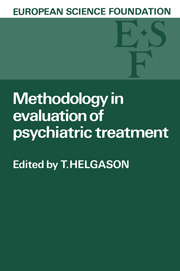 Methodology in Evaluation of Psychiatric Treatment
Methodology in Evaluation of Psychiatric Treatment from III - RATING METHODS IN EVALUATION OF TREATMENT
Introduction
The primary goal of psychiatric treatment is to cure or, at least, to improve mental disorders at the lowest possible risk for the patient. The reduction of symptoms usually serves as a measure of success in reaching this goal. Therefore, the quantification of psychiatric symptoms is a basic requirement for the evaluation of the efficacy of therapeutic efforts. The introduction ofmodern psychopharmacological treatment and also that of behaviour therapy in psychiatry has stimulated the development of a psychopathometric approach (von Zerssen 1980; von Zerssen & Moller 1980) which is surveyed comprehensively by Cronholm & Daly in this volume. The authors rightly point out that, with respect to rating procedures, “self-rating may be complementary to expert rating”, because “different aspects may be observed and the sources of error” are different (von Zerssen & Cording 1978). In the following paper these statements will be commented on in more detail.
General considerations
As compared with expert rating (Mombour 1972; Pichot & Olivier-Martin 1974), self-rating is simpler because it does not require highly skilled specialists (well-trained psychiatrists or clinical psychologists) as raters; the patients themselves rather perform the task of indicating the presence or absence of disturbances and, in some rating scales, also that of marking their degree (frequencylintensity). The disturr bances in question are usually specified in a questionnaire whether for one global rating (e.g. that of ‘inner tension’) or for the rating of several (up to more than 100)items. They may also be presented in a graphical form as in the Visual Analogue Scale (Luria 1975).
Scale values are derived from the patient's check marks on the question naire, using a ‘key’ which can be programmed for electronic data processing. The scoring procedure is thus executed only by the patient, by technical personnel, and, if available, by a computer. The scale values may be based on a global rating or, as sum-scores, on a number of scores obtained from individual items. In unidimensional scales, the items of a questionnaire all belong to one construct (e.g. ‘anxiety’), in two- or multidimensional scales, they are distributed among two or more constructs (e.g. ‘anxiety’, ‘hostility’ and the like). Generally, the constructs are either conceived as clinical syndromes or represent dimensions of factorial analyses of questionnaire items. This is also analogous to the conception of clinical rating scales.
To save this book to your Kindle, first ensure [email protected] is added to your Approved Personal Document E-mail List under your Personal Document Settings on the Manage Your Content and Devices page of your Amazon account. Then enter the ‘name’ part of your Kindle email address below. Find out more about saving to your Kindle.
Note you can select to save to either the @free.kindle.com or @kindle.com variations. ‘@free.kindle.com’ emails are free but can only be saved to your device when it is connected to wi-fi. ‘@kindle.com’ emails can be delivered even when you are not connected to wi-fi, but note that service fees apply.
Find out more about the Kindle Personal Document Service.
To save content items to your account, please confirm that you agree to abide by our usage policies. If this is the first time you use this feature, you will be asked to authorise Cambridge Core to connect with your account. Find out more about saving content to Dropbox.
To save content items to your account, please confirm that you agree to abide by our usage policies. If this is the first time you use this feature, you will be asked to authorise Cambridge Core to connect with your account. Find out more about saving content to Google Drive.